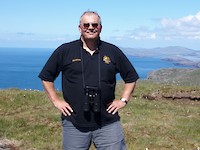Orkney is famous for being wet, cold, bleak, barren…and dark in the winter.
There’s nothing to do, people imagine, apart from huddle round the peat fire, with the straw cowl on your Orkney chair protecting you from the draught whistling under the croft house door.
The worst time, of course, must be the winter solstice. This is the shortest day, bringing with it the longest night – a time for hibernation.

The solstice is a magical time however. It is acted out in deep space like a dance between Sun and Earth – a celestial paso doble. At the climax the Earth reaches a point, in its annual orbit, when the Northern Hemisphere points more directly away from the Sun than at any other time. In 2018 this happened at 10:22pm on December 21st – towards the deepest part of the longest night. The days on either side are little different.
I went to the cinema in the morning. An odd time I know but films don’t have very long runs here and, in any case, the timing fitted in well with five-a-side walking football afterwards, in the sports hall next door.
Later we took a walk, Dog and I, along the cliffs at Orphir. It was 2-30pm and already the light was taking on that dusken quality unique to late December. An hour before dark at any other time is different, it’s almost as though the sky knows something we don’t. Artists and photographers are abroad. The air and sea were totally still. The loudest sounds came from the fulmars cackling on the ledges. I first heard this noise forty years ago, on a Hebridean pebble beach, in a cove between two vertical cliffs. The echo in the stillness amplified the primordial sound and I think of that day every time I hear it.

Goldeneyes, mergansers, mallards, eiders and wigeons drifted with their mates, waiting for a light cue in January that will trigger mating in earnest. The strengthening sun will penetrate their brains, cue in the hormonal orchestra and direct the reproductive performance. Already they suspect a change is coming so dare not let mates out of their sights. Four whooper swans visiting from the north flew overhead in line astern. I snapped them and the print shows wings alternately up and horizontal in perfect symmetry from front to back. Their rise and fall was perfect – an aerial waltz perhaps. Duncansby Head (20 miles away) and the Scarabens (mountains in Sutherland 50 miles away) were clearly visible on the Scottish mainland, through the clear air.

On our way back to the house it was already civic twilight – the horizon was still visible and objects could still be made out. The Orkney Islands Council provided our village street lights with Christmas illuminations again this year and I am pleased we had our old friend the red snowflake on our post. When new friends were due it was handy being able to say “Look for the red snowflake”. Along the street there were skiing santas, snowmen and reindeer in blue, green and yellow.
Just time to shower and change before hurrying down to St Magnus Cathedral for the evening performance of Rutter’s Magnificat given by The Winter Choir and Orkney Camerata in aid of Malawian children in need. The cathedral sound is fabulous but the twelfth century planners did not anticipate twenty first century audiences. If you want a good seat you must get there early so I queued in the cold with other enthusiasts and, when the doors opened, secured a spot on the third row. The concert-goer first in line said “I need to be close enough to see the cellist’s shoes”. She declared herself happy in this regard when we spoke at the interval.

By now it had passed civic twilight, nautical twilight, even astronomical twilight and was proper dark. Light from the town’s Christmas lights made viewing of The Milky Way and Northern Lights impossible when the cathedral turned out, we had to wait until the road across Hobbister Moor for those treats.
Next day there were just a few flocks of lapwing, curlew and greylag geese flapping by, competing for the prize for best Charleston I thought, so still not much going on.
 Richard contributes regularly to Scottish Islands Explorer magazine and his first book: 'Scotland’s Islands – A Special Kind of Freedom' was published in 2014. His new book 'Orkney – A Special Place' is available from all the usual outlets now.
Richard contributes regularly to Scottish Islands Explorer magazine and his first book: 'Scotland’s Islands – A Special Kind of Freedom' was published in 2014. His new book 'Orkney – A Special Place' is available from all the usual outlets now.
The Digital Orkney project has been part financed by the Scottish Government and the European Community Orkney LEADER 2014-2020